Cataulacus intrudens (F. Smith)
 "intrudens"
group: "intrudens"
group:  "rugosus"
group "rugosus"
group Type location South
Africa (Meranoplus intrudens, F. Smith, 1876d: 609,
illustrated, all forms; placed in Cataulacus by Mayr, 1886c: 364) - queen see below Type location South
Africa (Meranoplus intrudens, F. Smith, 1876d: 609,
illustrated, all forms; placed in Cataulacus by Mayr, 1886c: 364) - queen see below
junior synonyms
batonga (Cataulacus
Baumi For. r. Batonga
n. stirps, Forel, 1913a: 114, worker) from Zimbabwe - see below
baumi (Catulacus
Baumi n. sp., Forel, 1901d: 304, all forms) from Angola
- see http://www.antweb.org/specimenImages.do?code=casent0904882
bulawayensis (Cataulacus
Baumi For. r. Batonga
For. v. bulawayensis, Forel,
1914d: 218; Arnold, 1917: 391,
worker & queen) from Zimbabwe - see http://www.antweb.org/specimenImages.do?code=casent0909220
densipunctatus (Cataulacus
johannae For. r. densipunctatus
n. stirps, Stitz, 1923: 163, worker) from Namibia - no images
on Antweb (September 2014)
foveosquamatus (Cataulacus
foveosquamatus n. stirps, Santschi, 1937a: 58, illustrated,
queen) from South Africa - see http://www.antweb.org/specimenImages.do?name=casent0912552
gazanus (Cataulacus
baumi For. v. gazanus
n. var., Santschi, 1928f: 208, worker) from Mozambique - see http://www.antweb.org/specimenImages.do?code=casent0912553
hararicus (Cataulacus
hararicus n. spec., Forel, 1894b: 79, worker) from Ethiopia
- see http://www.antweb.org/specimenImages.do?code=casent0909224
intermedius (Cataulacus
intrudens Sm. stirps intermedius
n. stirps, Santschi, 1917b: 287, worker) from Zimbabwe - see http://www.antweb.org/specimenImages.do?name=casent0912554
johannae (Cataulacus
Johannae n. sp., Forel, 1895c: 250, worker & queen) from Madagascar
- no images on Antweb (September 2014)
pseudotrema (Cataulacus
baumi Forel stirps pseudotrema
n. st., Santschi, 1926b: 244, worker) from Tanzania - see http://www.antweb.org/specimenImages.do?name=casent0912555
rugosus (Cataulacus
intrudens Smith var. rugosus
n. var., Forel, 1894b: 78, worker) from Mozambique - see http://www.antweb.org/specimenImages.do?name=casent0909234
subrugosus (Cataulacus
rugosus For. var. subrugosus
n. var., Santschi, 1914e: 26, worker; Santschi,
1937d: 236, queen) from South
Africa (queen from Angola) - see http://www.antweb.org/specimenImages.do?name=casent0912557
umbilicatus (Cataulacus
umbilicatus n. sp., Santschi, 1937a: 59, illustrated,
queen) from Mozambique - see http://www.antweb.org/specimenImages.do?code=casent0900262
plus unavailable names
krugeri (Cataulacus
rugosus For. krugeri var.
nov. Prins, 1965d: 104, all forms) from South
Africa - no images on Antweb (September 2014)
tangana (Cataulacus
baumi Forel stirps pseudotrema
Sants. v. tangana, Santschi,
1928f: 209, worker & queen)
from Tanzania - see http://www.antweb.org/specimenImages.do?name=casent0912556
all forms known (in Bolton, 1974a: 43, illustrated)  . .
|
 A group with
fine or reduced sculpturation on the
basal gaster - intrudens plus batonga, hararicus
and intermedius - A group with
fine or reduced sculpturation on the
basal gaster - intrudens plus batonga, hararicus
and intermedius -
Smith's (1876d) description of Meranoplus intrudens from South
Africa is at  - note that although Smith appeared to
refer to an illustration of the worker, for comparison with the queen,
his illustrations are of the queen and the male. A partial
transcription (wrongly titled Smith, 1879) was given by Arnold (1917:
391), this is at - note that although Smith appeared to
refer to an illustration of the worker, for comparison with the queen,
his illustrations are of the queen and the male. A partial
transcription (wrongly titled Smith, 1879) was given by Arnold (1917:
391), this is at  . Forel's (1913a)
description of batonga from Zimbabwe is at . Forel's (1913a)
description of batonga from Zimbabwe is at  . An illustrated translation was given by
Arnold (1917: 389), this is at . An illustrated translation was given by
Arnold (1917: 389), this is at  . Forel's (1894b) description of hararicus
from Ethiopia is at . Forel's (1894b) description of hararicus
from Ethiopia is at  .
Forel's (1895c) description of johannae
from Madagascar is at .
Forel's (1895c) description of johannae
from Madagascar is at  . Santschi's (1917b)
description of intermedius
from Zimbabwe is at . Santschi's (1917b)
description of intermedius
from Zimbabwe is at  . A translation was given by Arnold (1920a:
403, 404), this is at . A translation was given by Arnold (1920a:
403, 404), this is at  . .
|
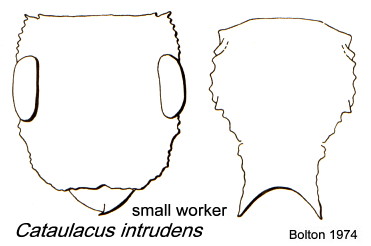 Bolton
(1974a: 42ff) synonymized the many names given
above and drew attention to this species, which he describes as the
most common of the genus in southern and eastern Africa, and appears to
recognise two main groups (also separated as far as South Africa was
concerned in a key by Arnold, 1920a: 403), this is at Bolton
(1974a: 42ff) synonymized the many names given
above and drew attention to this species, which he describes as the
most common of the genus in southern and eastern Africa, and appears to
recognise two main groups (also separated as far as South Africa was
concerned in a key by Arnold, 1920a: 403), this is at  . Bolton's modern description (1974a) is at . Bolton's modern description (1974a) is at
 and and  . .
|
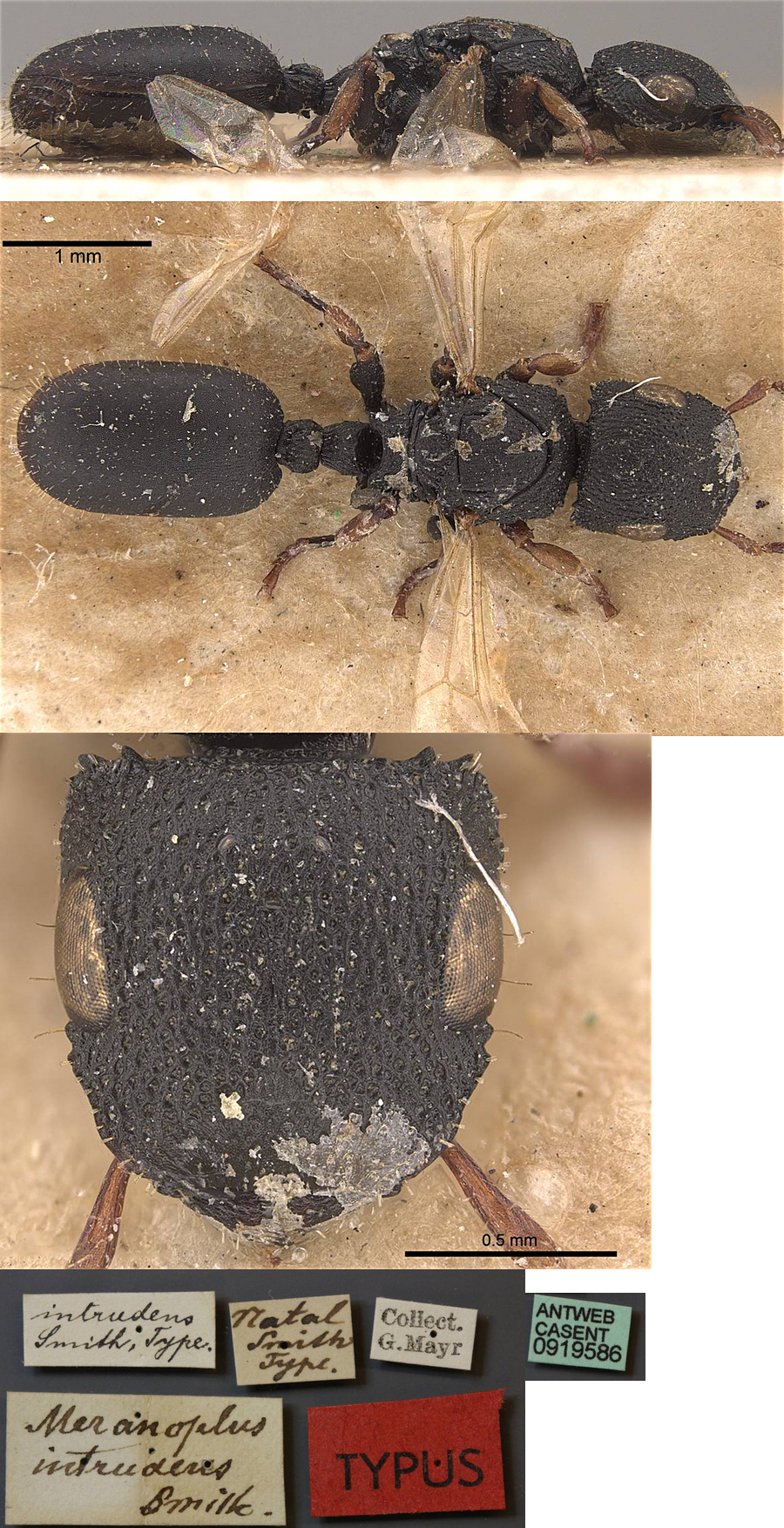 The
photomontage of the type queen is collated from http://www.antweb.org/specimen.do?name=casent0919586. The
photomontage of the type queen is collated from http://www.antweb.org/specimen.do?name=casent0919586.
Bolton
(1974a) related how he could not locate the F Smith queen in the BMNH
and "this is presumed lost or destroyed". This specimen, however,
clearly has all the right labelling, the original description being as Meranoplus intrudens. In his notes on ants in the BMNH collection, Mayr (1886c: 364) referred to Smith (1876) and that the Meranoplus intrudens belonged to Cataulacus.
Mayr said that he had visited London in the summer of 1884. Curiously,
Antweb does not seem to have found, or at least, photographed the BMNH
specimen Bolton that designated as the lectotype worker.
|
 The photomontage of
the batonga cotype is
collated from http://mcz-28168.oeb.harvard.edu/mcz/FMPro?-DB=Image.fm&-Lay=web&-Format=images.htm&Species_ID=29235&-Find The photomontage of
the batonga cotype is
collated from http://mcz-28168.oeb.harvard.edu/mcz/FMPro?-DB=Image.fm&-Lay=web&-Format=images.htm&Species_ID=29235&-Find
|
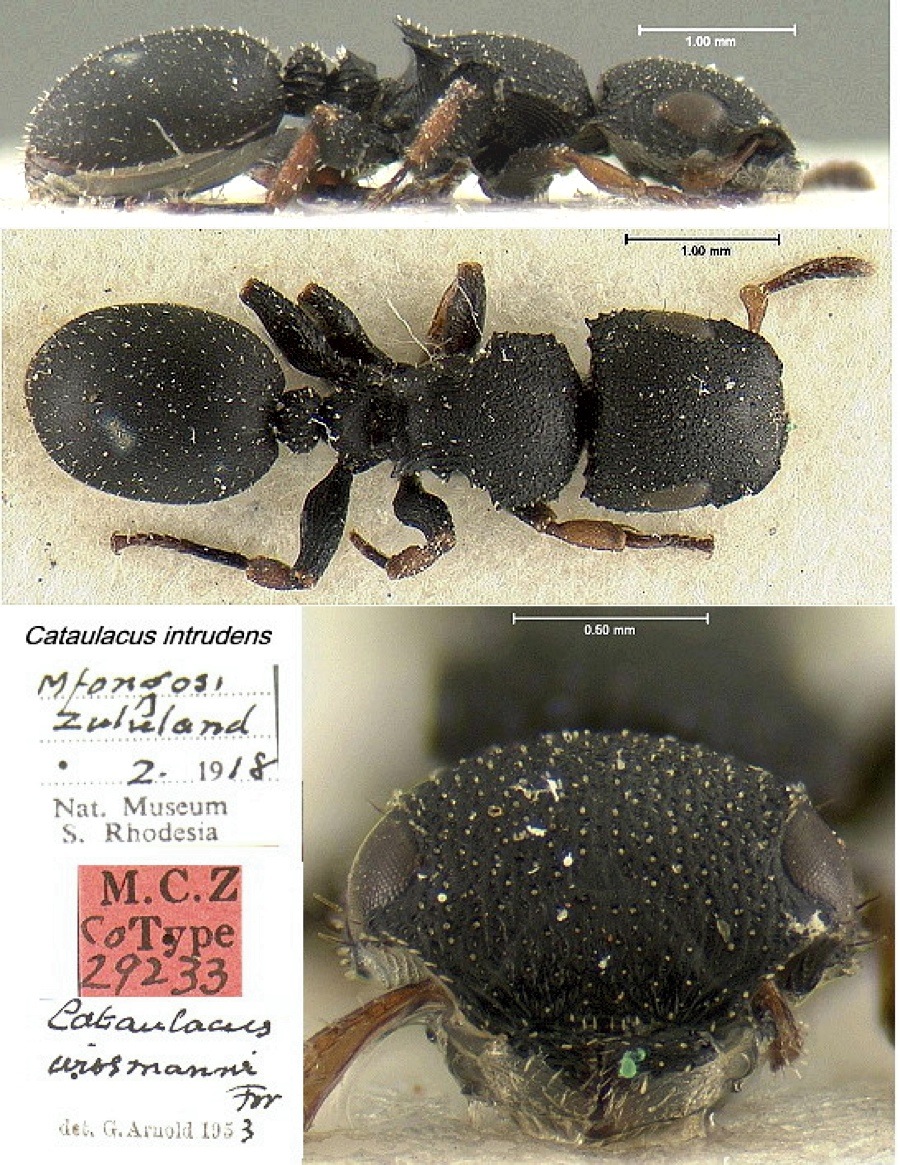 The photomontage of
a specimen apparently wrongly
identifed as wissmanni is collated from http://mcz-28168.oeb.harvard.edu/mcz/FMPro?-DB=Image.fm&-Lay=web&-Format=images.htm&Species_ID=29233&-Find The photomontage of
a specimen apparently wrongly
identifed as wissmanni is collated from http://mcz-28168.oeb.harvard.edu/mcz/FMPro?-DB=Image.fm&-Lay=web&-Format=images.htm&Species_ID=29233&-Find
|
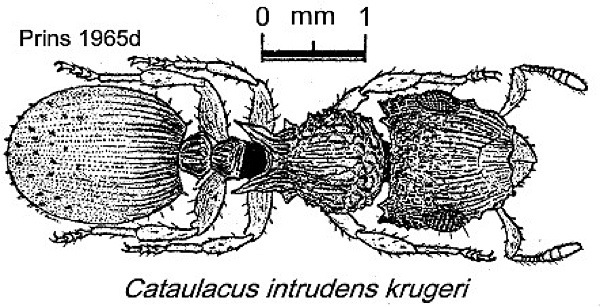 A group with
coarse sculpturation on the basal gaster
- rugosus plus baumi, bulawayensis, krugeri,
pseudotrema, gazanus, subrugosus and
tangana - A group with
coarse sculpturation on the basal gaster
- rugosus plus baumi, bulawayensis, krugeri,
pseudotrema, gazanus, subrugosus and
tangana -
Forel's (1894b) description of rugosus from Mozambique is at  . A translation was given by Arnold (1917:
392), this is at . A translation was given by Arnold (1917:
392), this is at  . Forel's (1901d)
description of baumi from Angola is at . Forel's (1901d)
description of baumi from Angola is at  . A translation was given by Arnold (1917:
388), this is at . A translation was given by Arnold (1917:
388), this is at  . Forel's (1914d: 218)
description of bulawayensis from Zimbabwe is at . Forel's (1914d: 218)
description of bulawayensis from Zimbabwe is at  . Arnold's (1917: 391, 1920a: 404)
translation of bulawayensis is at . Arnold's (1917: 391, 1920a: 404)
translation of bulawayensis is at  . Santschi's (1914e) description of subrugosus
from South Africa is at . Santschi's (1914e) description of subrugosus
from South Africa is at  , Arnold's translation is on the rugosus
card (above). Santschi's (1926b) description of pseudotrema
from Tanzania is at , Arnold's translation is on the rugosus
card (above). Santschi's (1926b) description of pseudotrema
from Tanzania is at  . Stitz's (1923) description of densipunctatus
from Namibia is at . Stitz's (1923) description of densipunctatus
from Namibia is at  . Santschi's (1928f) description of gazanus
from Mozambique is at . Santschi's (1928f) description of gazanus
from Mozambique is at  . Santschi's (1928f) description of tangana
from Tanzania is at . Santschi's (1928f) description of tangana
from Tanzania is at  . Prins's (1965b) description of krugeri
from South Africa is at . Prins's (1965b) description of krugeri
from South Africa is at  . .
|
|
Smith (1876d) reported observations by J.M. Hutchison,
at Weenen in South Africa, of the species making formicaria in the
thorns of a species of acacia.
Queens only are known of - Santschi's (1937a)
description of foveosquamosus from South Africa is at  and his description of umbilicatus
from Mozambique is at and his description of umbilicatus
from Mozambique is at  . .
|
Oxford University Museum
specimens
Cataulacus intrudens
B Taylor det.
|
Tanzania
G McGavin
tree 5-55
|
13.i.1997
Mkomazi
|
ppkd collection from
Acacia nilotica;
37M 0375378 UTM 9571003 |
2
|
 |
Cataulacus intrudens
B Taylor det.
|
Tanzania
G McGavin
tree 3-66
|
16.i.1996
Mkomazi
3°57.996' S
37°48.128' E
|
pkd collection from Lannea schweinfurthii
|
1
|
|
Cataulacus intrudens
B Taylor det.
|
Tanzania
G McGavin
tree 3-67
|
16.i.1996
Mkomazi
3°57.996' S
37°48.128' E
|
pkd collection from Lannea schweinfurthii |
4
|
 |
Cataulacus intrudens
B Taylor det.
|
Tanzania
G McGavin
tree 2-15
|
9.v.2007
Awae II
03°54'30" N
11°25'58" E
|
.
|
2
|
|
Cataulacus intrudens
B Taylor det. |
Namibia
H Campbell
Tree 09
|
07.ix.2009
Windhoek
23°13.836' S
18°24.097' E
|
Kuzikus Wildlife
Reserve; 1340 m
inside thorn on Acacia erioloba
|
1
|
 |
Cataulacus intrudens
B Taylor det. |
Namibia
H Campbell
Tree 166
|
31.viii.2009
Windhoek
23°12.557' S
18°23'25" E
|
Kuzikus Wildlife
Reserve; 1340 m
inside thorn on Acacia erioloba |
1
|
 |
|
 The
photomontage is of a worker (hw 1.05 mm; dark scape; dark eyes) from Tanzania,
Mkomazi Game
Reserve, collector G McGavin (Tz 3-67). This appears close to the
description of
the variety tangana given by Santschi (1928f), type location
Tanga, Tanzania. The
photomontage is of a worker (hw 1.05 mm; dark scape; dark eyes) from Tanzania,
Mkomazi Game
Reserve, collector G McGavin (Tz 3-67). This appears close to the
description of
the variety tangana given by Santschi (1928f), type location
Tanga, Tanzania.
|
 The
photomontage is of a large worker (HW 1.35 mm; orange scape; orange
eyes) from Tanzania, Mkomazi Game Reserve; collector G McGavin
(tz 5-55-3). The
photomontage is of a large worker (HW 1.35 mm; orange scape; orange
eyes) from Tanzania, Mkomazi Game Reserve; collector G McGavin
(tz 5-55-3).
|
 The
photomontage is of a smaller worker (HW 1.1 mm) from Tanzania,
Mkomazi Game Reserve; collector G McGavin (tz 5-55-3-2). The
photomontage is of a smaller worker (HW 1.1 mm) from Tanzania,
Mkomazi Game Reserve; collector G McGavin (tz 5-55-3-2).
|
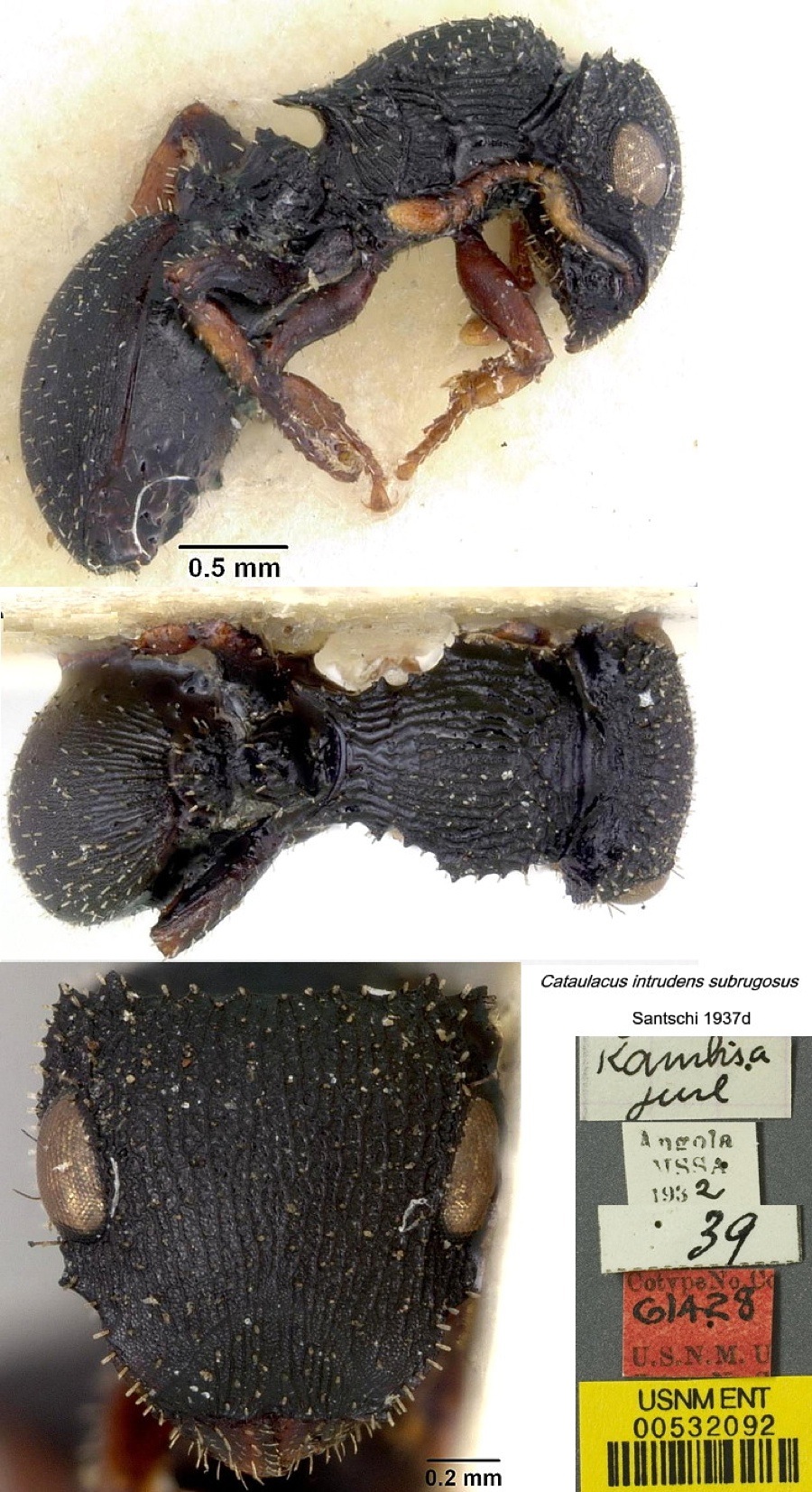 The photomontage
of subrugosus is collated from
The Smithsonian Institute cotype images at http://ripley.si.edu/ent/nmnhtypedb/public/specimeninfopage.cfm?publicconsumption=1&typespecimenID=759 The photomontage
of subrugosus is collated from
The Smithsonian Institute cotype images at http://ripley.si.edu/ent/nmnhtypedb/public/specimeninfopage.cfm?publicconsumption=1&typespecimenID=759
Note: this is labelled as a cotype but was collected in Angola,
Kambisa and Kampulu, Kasinga Region, vii.1932, 80 km S. of Vila-de
Ponte (Santschi, 1937d); whereas the type location was in South Africa.
Santschi's (1937d) illustrated description of the subrugosus
queen is at  |
 The
photomontage is of a small worker (HW 0.8; orange scape; orange
eyes) from Namibia, Mkomazi Game Reserve; collector H Campbell
(Tree 09). The
photomontage is of a small worker (HW 0.8; orange scape; orange
eyes) from Namibia, Mkomazi Game Reserve; collector H Campbell
(Tree 09).
|
 The
photomontage is of a large worker (HW 1.35 mm; orange scape; dark
eyes) from Namibia, Kuzikus Wild Life Reserve; collector H
Campbell
(Tree 166). The
photomontage is of a large worker (HW 1.35 mm; orange scape; dark
eyes) from Namibia, Kuzikus Wild Life Reserve; collector H
Campbell
(Tree 166).
|
|